This section contains entries about our botanizing in Baja California written for the UC BEE (Oct 2012 to Aug 2021)
and The UC Hive (2022-), monthly newsletters for volunteers and staff of the UC Berkeley Botanical Garden.
Click on any photo for a larger image.
BEE APRIL 2019
What´s that Plant?
This month I continue where I left off last month on my goal of clarifying the identification of a few Baja California plants species that are commonly misidentified by visitors.
So, to begin, while a number of the cholla cactus that are found on the peninsula resemble what southwest US desert aficionados “lovingly” refer to as Teddy Bear Cholla, or perhaps less happily as “Jumping” Cholla, the species (Cylindropuntia bigelovii) is just one of many on the peninsula.
Is it a Teddy Bear Cholla?
Cylindropuntia bigelovii is most common in the northeast portion of the Baja California desert, where its US range crosses south over the border and continues along the Gulf coast, petering out by mid-peninsula. Travelers headed along the main highway are more likely to see a variety of other peninsular endemic Chollas.
In total, there are 37 recognized Cholla taxa on the peninsula: 16 species, 12 subspecies and 9 hybrids [1]. Many are rare and restricted to small areas, while others are quite common. Twenty-seven of these taxa are endemic to the peninsula. Below are some of the likely ones you may see in your travels down the transpeninsular highway or when off on a few of its branch roads.
Peninsular Cholla / Cholla Barbona
(Cylindropuntia alcahes var. alcahes)
A common and widespread endemic variety, ranging from around El Rosario southward to the Sierra la Giganta range. It is also found on Isla Cedros and a number of Gulf islands.
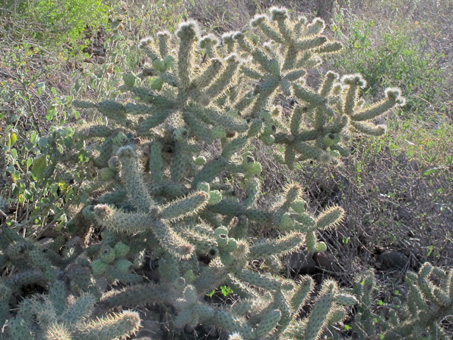
A shrub or tree to 3 m tall with many branches. Spines are white, yellow or rust-colored.
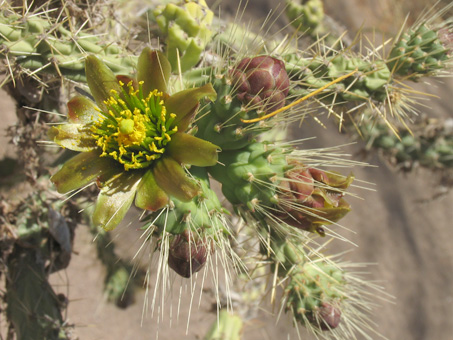
Or a darker greenish-yellow tinged with red and reddish tips on outer tepals. In all cases, the filaments are green.
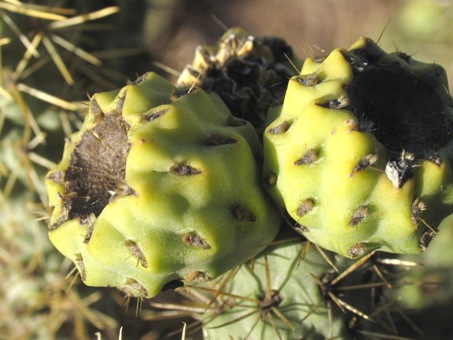
Fruit are spiny when young, but mostly bare when mature.

The flowers are also variable. All tepals may be yellow, with just the outer ones red-tipped (or not).

Or the inner tepals may be red or magenta (even darker than this specimen) while the outer ones are greenish with a red midstripe.
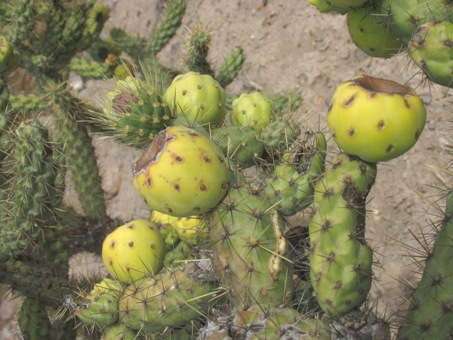
They may be more angular (L) or rounded (above). They are dryish.
Teddy-Bear Cholla / Cholla del Oso / Cholla Guëra
(Cylindropuntia bigelovii)
As noted above, this native species occurs in the desert regions of southern California and Arizona, and from ne BC to s BC along the Gulf
coast. It also occurs rarely near Laguna San Ignacio, BCS in the Vizcaino Desert. (Photos: Internet).

Shrub or tree, 0.5-1.5 m tall. The distinct trunk is usually black or dark-brown. Propagates mainly by vegetative means due to easily detachable segments.

Outer tepals yellow-green with reddish midstripe and tip. Inner tepals are yellow, yellowish green or whitish cap
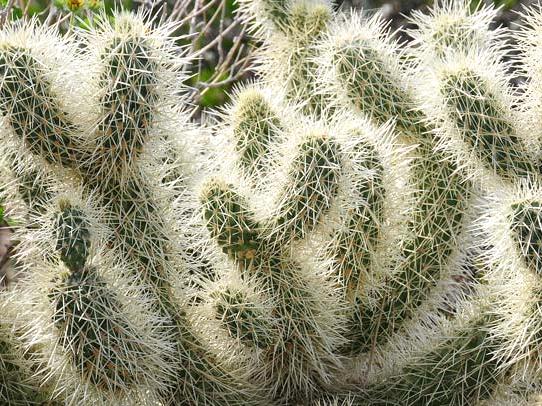
Spines are whitish and densely packed. Each spine has microscopic barbs that make extraction difficult and painful.
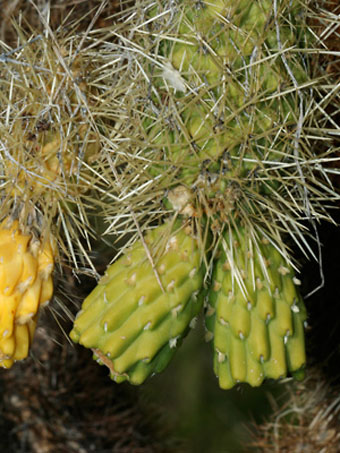
Fruit lack spines, are green to yellow, more or less cylindrical, and mostly sterile.
Southern Teddy-Bear Cholla / Ciribe
(Cylindropuntia ciribe)
Ciribe is an endemic species restricted to the Pacific side of the peninsula from around Laguna San Ignacio southward to around the Comondús.

The growth habit is very low, dense, and multi-branched.
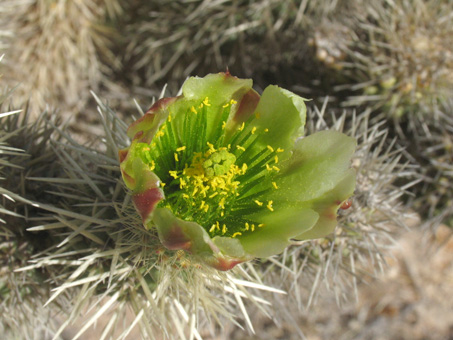
Flower color similar to the green-yellow of C. alcahes var. alcahes.
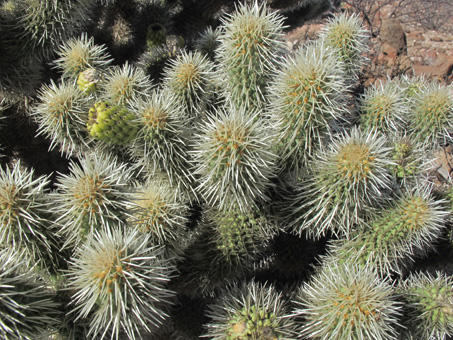
Stems are tightly attached. Spines are silvery, similar to C. bigelovii.
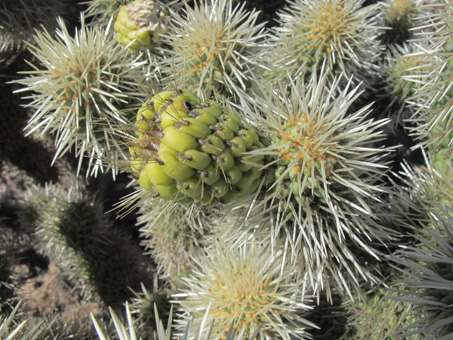
Fruit are somewhat spiny.
Chainlink Cholla / Baja California Cholla / Cholla Pelona
(Cylindropuntia cholla)
It's hard to mistakenly call this endemic a Teddy Bear Cholla. Its common name in Spanish means the "bald cholla". New growth is commonly covered with many short, pale, heavy spines. It is one of the most ubiquitous and widespread species, showing up around Colonet (nw BC) and continuing all the way to the Cape. It is also found on a number of Gulf and Pacific coast islands.
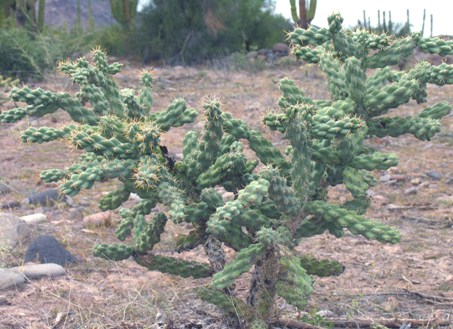
A shrub or small tree with a definite trunk to 3 m H. The segments are moderately easy to detach once they have penetrated hide or skin. As in many Cholla species, barbed spines make removal difficult.
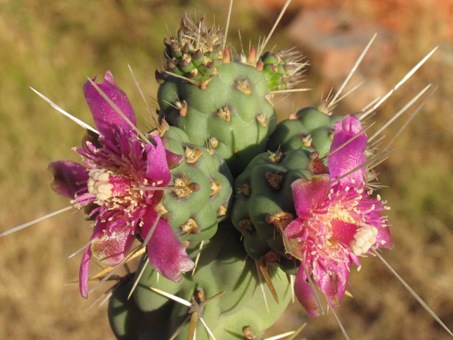
Tepals are few, unusually open and appearing rotate.
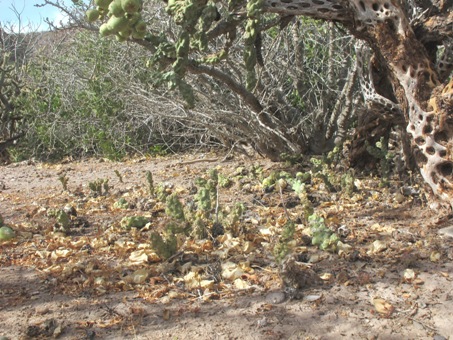
This is a common sight beneath many Chollas and across the desert: stems that have fallen to the ground take root and start new plants. Notice the Cholla's "woody" skeleton on the right.
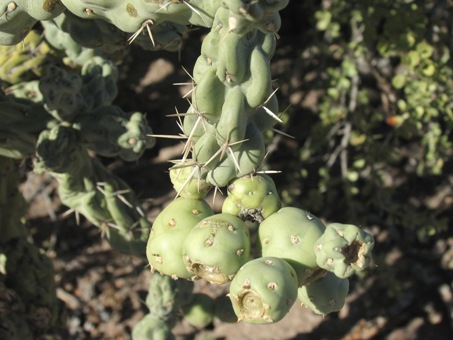
Fruit commonly grow in a chain from one season to the next. They are fleshy but unpalatable (to humans).
Cataviña Cholla
(Cylindropuntia ganderi var. catavinensis)
While considered an uncommon species on the peninsula (it grows mainly in the Central Desert), this endemic variety is quite abundant and noticeable around Cataviña. It ranges south from there to around Santa Rosalillita. It can also be found on the Gulf side near Bahía San Luis Gonzaga.
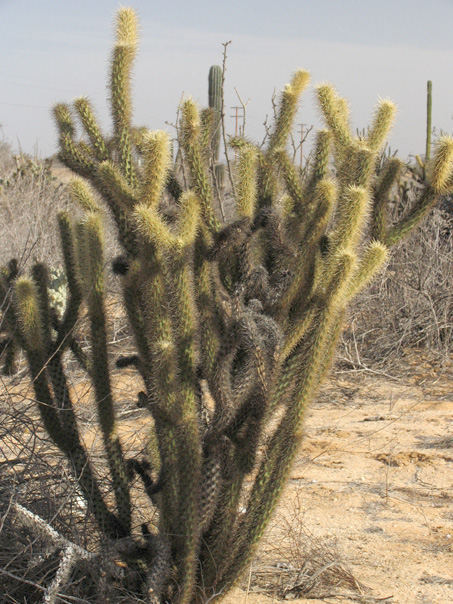
Stems are tightly clustered, mostly erect, and branch mostly near the tops of the stems. The long, dense spines are white, yellow or rust-colored.

Flowers are yellow with green filaments. They arise from near the tips. The dry fruit is spiny and globose.
Long-Spine Cholla / Clavellina
(Cylindropuntia molesta var. molesta)
Another endemic species, Clavellina is found primarily in the Central Desert from around San Quintín, BC south to San
Ignacio. It also occurs on adjacent Isla Tortuga. I would be interested to know the story of how this plant got its Spanish common name since "Clavellina" refers to a plant that looks like a carnation, only smaller! Perhaps a missionary after one too many glasses of sacramental wine...?
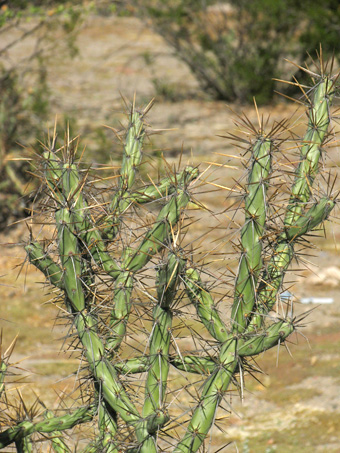
Can be a shrub or tree up to 2.5 m H. Stems are easily detached & slender with elongated tubercles.
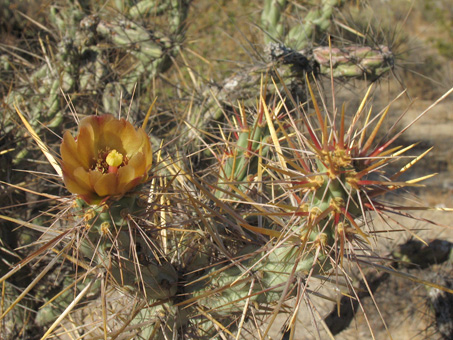
Inner tepals range in color from yellow to this bronzy-orange sample...

The fruit is spiny and conical or ovoid...
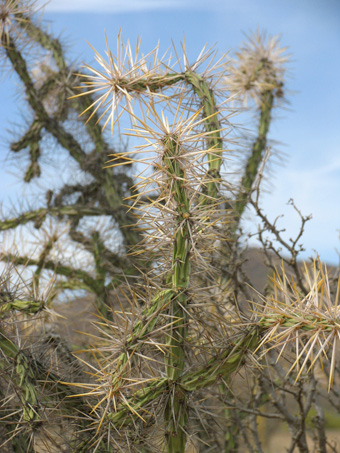
The main spines are among the longest of any Cholla (3-6 cm) and have a pale, loose, papery sheath.
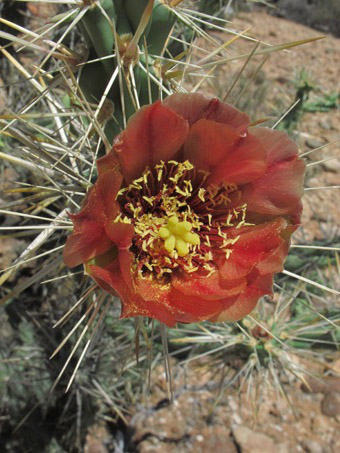
...to this even darker wine-colored specimen. Filaments are red or maroon.
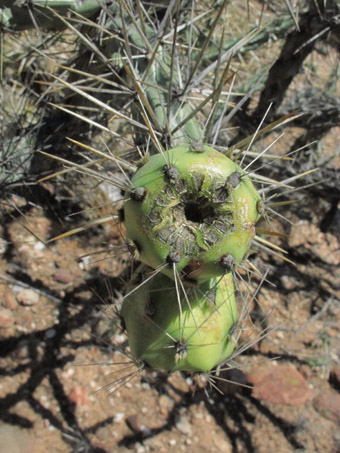
...with a deep flower scar. The fruit is fleshy but unpalatable.
Ocotillo or Palo Adán?
And now to the last group of plants I will discuss this month: the Ocotillo Family (Fouquieriaceae).
There are three species of Fouquieria on the peninsula which are easily confused by visitors, while a fourth species (which I won´t cover here), the Boojum Tree or Cirio (F. columnaris) would be difficult to mistake for any other species of plant on the peninsula.
Ocotillo (Fouquieria splendens) is found in the southwest deserts of California, Arizona, and to Texas. It ranges across the border as far south as the Sierra la Giganta/Sierra Guadalupe in northern BCS.
Palo Adan (F. diguetii) has a more southern distribution than Ocotillo. The two species overlap beginning around Bahía de los Ángeles (BC) and Palo Adán continues to the Cape.
In BCS, F. diguetii overlaps with the endemic white Palo Adan (F. burragei) along the Gulf coast from just north of Mulege to the shores of Bahia de La Paz.
All three species have thin, spiny, whip-like (often contorted) stems, tubular flowers, and a three-valved capsule filled with very small, papery-margined seeds that is persistent on the inflorescence. Stems also have some photosynthetic tissue that keeps the plant´s metabolism in idle and gives it an advantage in rapid leaf production after minor rains.
Coachwhip / Ocotillo
(Fouquieria splendens)
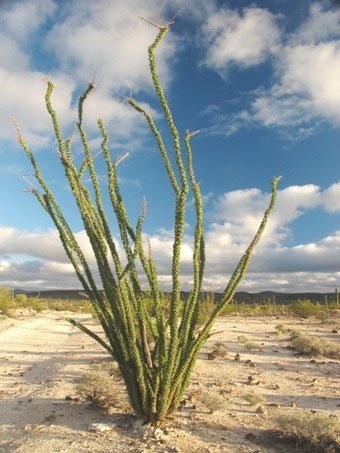
Once you know what to look for, Ocotillos are easy to tell apart from other peninsular species in the family. Ocotillos have no trunk and the numerous whip-like stems are sparsely branched, usually above midstem.
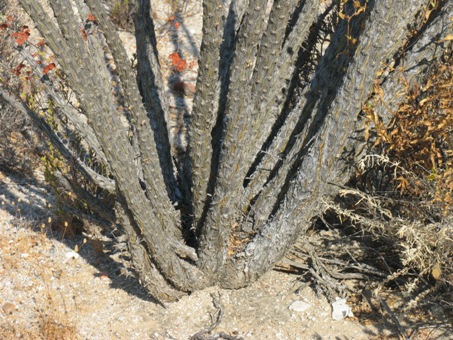
No trunk, stems start to diverge slightly right at the base (crown).
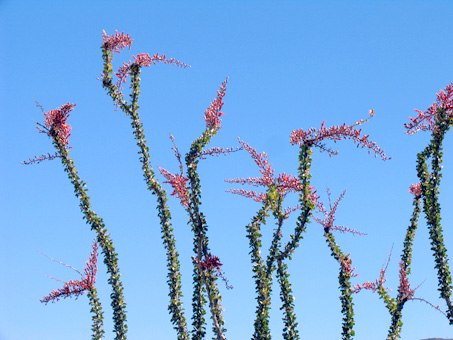
Inflorescences are terminal panicles to about 25 cm L.
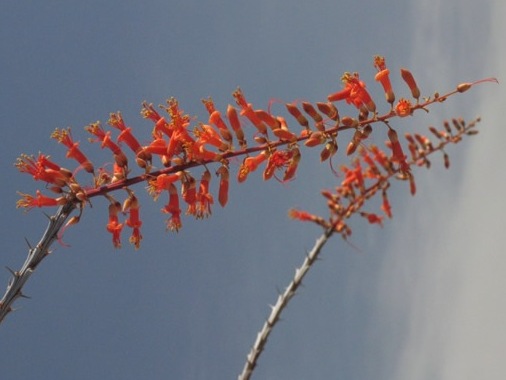

Flowers are orange-red and tubular, the lobes curled backwards. They gen. have >10 stamens (12-15).
Tree Ocotillo / Palo Adán
(Fouquieria diguetii)
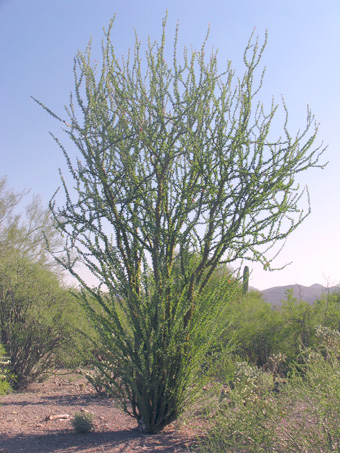
Palo Adan is also many stemmed, but has a short, distinct trunk with many stems that are branched at any height and are often very contorted.
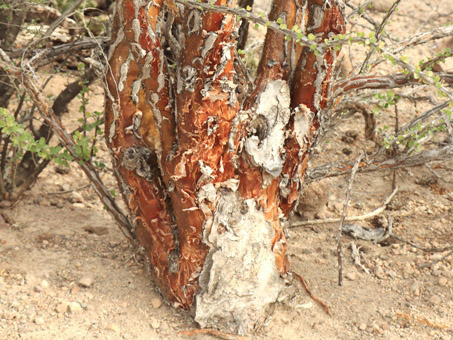
A conspicuous trunk (here about 30 cm), with stems diverging from just above the trunk. The bark is commonly striped and peely.

Panicles are terminal or along the stem near the tips, are somewhat pyramidal, and are about 10-15 cm L.
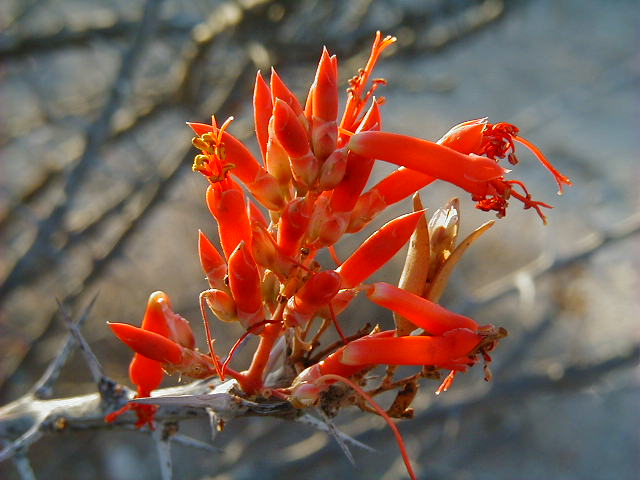

The scarlet tubular flowers are about 25-30 mm L, have lobes that are almost erect, and usually only 10 stamens. The capsule is 20-25 mm L.
Gulf Coast Tree Ocotillo / Palo Adan
(Fouquieria burragei)
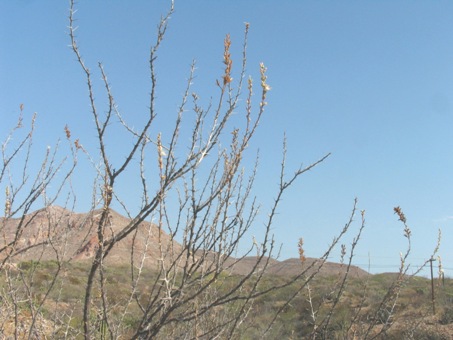
When not flowering, this species is difficult to distinguish from F. diguetii. I always look for the old inflorescences, which are almost always singular and terminal. Finding a dry flower at the base is the clincher.
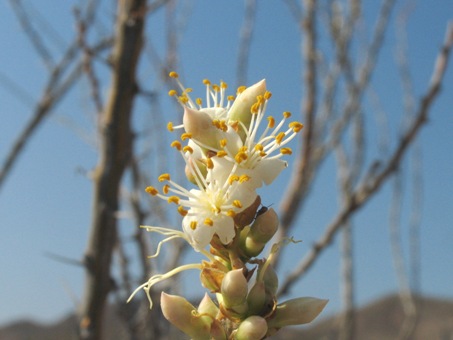
The flowers are smaller than F. diguetii, with a very short tube (7-9 mm) and spreading to reflexed lobes slightly longer than the tube. Color varies from white to pink.
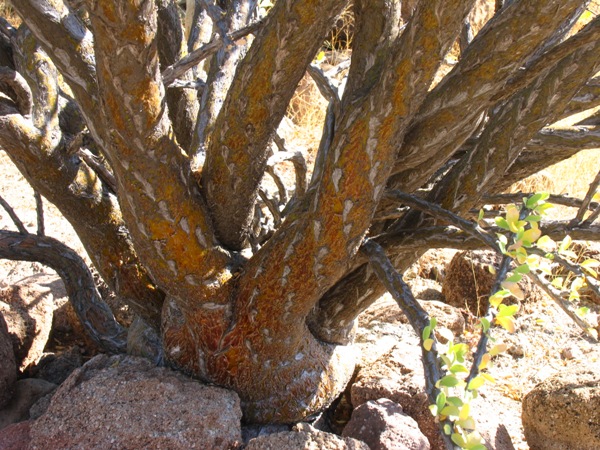
Like F. diguetii, it has a conspicuous trunk with striped, peely bark.
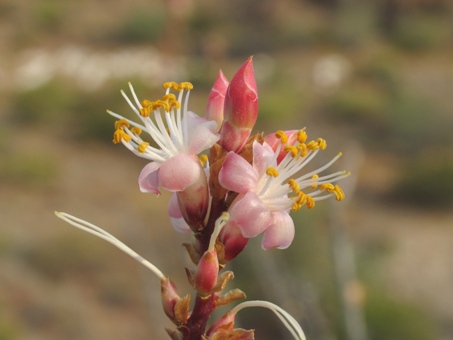
A pinker version of the flower. The fruit is about 12-15 mm L.
I hope both this month and last month´s articles have been interesting and helpful in distinguishing some of Baja California´s fascinating and diverse plant life. Let´s see what adventures next month brings. Until then, hasta la próxima…
Debra Valov—Curatorial Volunteer
References
[1] Rebman, J. P., J. Gibson, and K. Rich, 2016. Annotated checklist of the vascular plants of Baja California, Mexico, p. 5. Proceedings
of the San Diego Society of Natural History, No. 45, 15 November 2016. San Diego Natural History Museum, San Diego, CA.
Full text available online.
Rebman, J. P and Roberts, N. C. (2012). Baja California Plant Field Guide. San Diego, CA: Sunbelt Publications. Descriptions and distribution.
Wiggins, I. L. (1980). The Flora of Baja California. Stanford University Press. Descriptions and distribution.
(click on the link for the above reference to return to your previous location on this page)









































